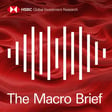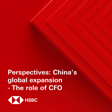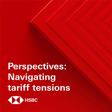Introduction and Expert Overview
00:00:00
Speaker
Welcome to HSBC Global Viewpoint, the podcast series that brings together business leaders and industry experts to explore the latest global insights, trends, and opportunities.
00:00:12
Speaker
Make sure you're subscribed to stay up to date with new episodes. Thanks for listening, and now onto today's show.
00:00:21
Speaker
Over the next 45 minutes, I'm delighted to be joined by James Pomeroy, who is a global economist with HSBC's research team, to step back and take stock of where we are. What is the landscape of trade?
00:00:35
Speaker
What's actually coming through and underlying macroeconomic fundamentals? And what should we be expecting for the next months and year ahead? James, over to you.
Understanding Global Trade Uncertainty
00:00:45
Speaker
Wonderful. you very much. And thank very much everyone, for giving me of your time to talk about everything that's happening in the world. it is a very, very uncertain one.
00:00:51
Speaker
And as a global economist, I'm spending a lot of my time at the moment thinking about tariffs and trade and all of the implications that it has, not just in terms of trade flows, but what it does to growth and inflation and policy setting across the world. But the key thing is about uncertainty and real challenges, I think, in terms of working out what is going to happen across the world in the rest of this year, but also in 2026.
00:01:12
Speaker
twenty twenty six And life is not being made any easier because we essentially have three different tariff parts we have to think about. We have to think about the partner tariffs, which we sort of know roughly what we're dealing with here. And I say sort of because we've had the trade deals, we've had the letters, we've got negotiations still going on, particularly the likes of Switzerland, India, potentially Brazil at some point and anyone else.
00:01:36
Speaker
But you've also got the challenging courts about whether these country tariffs are going to stay in place at all. But we have to sort of assume they do in our base case for now. But you also have on top of that the sectoral tariffs, which I think is where you're going to see a lot more interesting stuff happen, both in the back end of this year and next year.
00:01:51
Speaker
We don't know what tariff rate they're going to be set at Numbers up to 200 percent have been talked about when they'd come into place and how quickly tariffs would increase in those sectors.
00:02:02
Speaker
And this creates an enormous amount of uncertainty about the average tariff rate we're going to face, the average specifically for some countries, the tariff rate they're going to face. But also on top of that, you have carve outs and there's carve outs that come through for individual countries in terms of their trade deals, but also individual companies.
Tariff Exemptions and Macroeconomic Effects
00:02:18
Speaker
We're hearing examples of some companies paying less tariffs because of the end user or the end user of the products they're importing.
00:02:25
Speaker
All of this makes it very, very hard to work out the exact macro impact. We track a couple of series that they're on this chart here. One is the sort of policy announced tariff rate. But the more interesting one I think we have to follow is the red line there, which is the actual tariff rate paid by US companies. We get that with the trade data every month.
00:02:42
Speaker
So in ah in a week or so's time, we'll get the date for August. That's going to be particularly interesting because in August, you then have these higher tariffs that are put in place across the world. in August by sector and by country will get a clearer sense.
00:02:55
Speaker
But our sort of starting point is thinking about the effective tariff rates. You have to combine all of these things together. You have to combine the country tariff, the exemptions and the sectoral tariffs.
00:03:06
Speaker
And for most countries across the world, they look something like this. There's ranges you can apply and there's a number of ups and downs that will happen. But it's a rough guide here in terms of one where tariffs are highest today.
00:03:19
Speaker
in terms of effective tariffs when we take into account those exemptions, but also taking into account where they could go with some of these 232 tariffs. And it's not just about those additional tariffs that come into place. It's about the exemptions that could come off as well.
00:03:32
Speaker
So there's a big meeting coming up at the end of October with President Trump and Xi. Yes. ah The APEC meeting. ah So China tariffs, I think the expectation is that meeting will resolve quite a lot. But do we expect USMCA to get renegotiated?
00:03:49
Speaker
USMCA will probably be renegotiated in one way, shape or form. The problem is getting it completely renegotiated in sense of changing the amount of trade that crosses those borders would be a huge cost to all of those countries involved and particularly the auto sector.
00:04:03
Speaker
So in our sort of base case, and we're thinking about what's going to happen with tariffs what's going to happen with these trade flows, we're not sort of assuming some sort of complete rewrite that suddenly changes how many products coming out of Canada or Mexico are exempt because at the moment it's about 90 odd percent of the products.
Impact of Tariffs on Trade Dynamics
00:04:17
Speaker
coming out of Mexico or Canada into the US or exempt under USMCA. We don't expect that to be fundamentally changed because by fundamentally changing that, you would end up creating an enormous inflationary pressure into the US economy. You potentially lead to an enormous disruption for the businesses there and there. we could get supply shortages, there's a whole load of challenges that would create. And this is sort of what's been happening in terms of those tariff negotiations between the US, Mexico and Canada so far this year.
00:04:43
Speaker
is it's almost in everyone's interest to have free trade and very low trade barriers. And so actually rene proper full renegotiation to have a material impact on those trade flows seems unlikely.
00:04:53
Speaker
Some sort of nudging around the edges that might allow everyone to claim there's been a rethink and then newly happy with this deal seems a more likely outcome to me than a complete reset. and James, you mentioned I think it's fair for us to assume the Supreme Court doesn't challenge or revoke the tariffs that are in place.
00:05:11
Speaker
yes But I think by that you mean even if they were to, yeah ah the US administration can use Section 232 or Section 122, I think is the other one which allows them to use. They have a few other levers to put tariffs back in place.
00:05:25
Speaker
This is it. Exactly. So there's some economies who might be marginally better off if you change the mix of how those tariffs are put in place. But broadly, this sort of picture that's on this chart is not going to be wildly different. Almost whatever happens in the marine that to improved Supreme Court. And the tariff revenue has now become ah such an integral part of the US fiscal revenue generation.
00:05:44
Speaker
This is it. It's going to be tough to take it away. This is it. And I think that's worth keeping in mind, not just for the next sort of few years of the Trump administration, but any subsequent administration. Actually, by taking away that tariff revenue, you now need to find other revenues that involve tax rises or spending cuts within the economy. That's super hard to do.
00:06:00
Speaker
Taking tariffs away is really hard. And so we do think actually in our base case, what happens is a lot of these tariffs are going to stay in place for quite some time. Maybe they move around the edges, but this is a new world we're dealing with now. I don't see that changing an enormous amount.
00:06:12
Speaker
What you might get is that tariff policy adjusts around sectors and around countries based on what the US needs. And it could be actually it's the exemptions become particularly interesting. And a great example of this actually on is um South Africa, because does have an effective tariff rate that's quite high, but it's also got a ton of exemptions.
00:06:30
Speaker
So actually what you could see with South Africa is a much bigger shock as those exemptions start to fade out. So there's it's not just about the tariffs that come in, it's about the exemptions that drop out.
00:06:40
Speaker
And I think that's an area we have to be particularly careful. And that's the impact for somewhere like Mexico, right? So you've got the calculated duties, a share of imports. So that's the effective tariff rate on all imports going in. Whereas the black line is essentially the tariff rate paid on stuff that isn't exempt.
00:06:56
Speaker
So similar like Mexico is facing a 25% tariff on non-exempt products, but because so much of it's exempt, the actual effective tariff rate is much, much smaller. We just published our global quarterly this morning. We used an interesting chart in there that shows actually as of July, a lot of economies have got huge amounts of exemptions.
00:07:12
Speaker
And so actually the effective tariff rate is nowhere near what the sort of headlines look like. But that will change in August. And that's the particularly interesting data we get in a couple of months time to see where these sorts of lines go will give us a clearer sense of actually in practice what is happening.
Sector-Specific Trade Dynamics
00:07:27
Speaker
because so many of the charts like that previous one I showed was theoretical.
00:07:30
Speaker
What you actually want to see is what is happening on the ground in terms of those tariffs that are being paid. And for now, on an aggregate level, that tariff rate is about 10% rather than sort of 18% that the tariff policy would suggest. So if your corporate impacted today you're on the black line.
00:07:46
Speaker
Yes. And your economics and your fundamental model has changed or has to change quite a lot. Yeah. If your corporate which has yet to be impacted, you're on the red line, you're dealing with uncertainty and figuring out what do I plan for, what decisions do I make? Exactly. Hugely problematic for everyone, just different challenges.
00:08:02
Speaker
And at the moment, because of the exemptions that are in place, Canada and Mexico, even though directly are most exposed in terms of exports to the US, they're not really seeing the macro shock to an extent. Actually, Mexican economy has done okay. Canada has had a bit of a sort of up and down with trade flows and you're seeing some spillover into the sort of sentiment and investment in Canada.
00:08:21
Speaker
But actually, when you get into the next bucket of Asian economies, What um my colleagues in Asia are talking about is a relative game here. So if you're Vietnam, you look really exposed. 15% of GDP is goods exports to the us Tariffs are terrible for you.
00:08:33
Speaker
But actually, they're not that terrible for you because everyone else has got tariffs and your tariffs are not materially higher or lower than any of your direct regional competitors. And because your tariff is lower than China's,
00:08:43
Speaker
actually you might pick up market share. And as you sort of work your way down the list, the shock for a lot of these countries has been much, much smaller, at least so far, than we might have expected.
00:08:54
Speaker
Now the question you then have to think about is how much of that is just pure front loading and how much of it is actually that this doesn't matter. And global trade in 2025 has had a really, really strong year, really strong year.
00:09:05
Speaker
Actually, when you look at the left hand chart, here's just a couple measures of trade volumes. they've been really resilient and particularly off of the base effect of last year. And and normally to get 5% volume trade growth in global trade, it's coming out of a recession or a recovery to that point.
00:09:20
Speaker
And actually you can make a case that global trade in the first half of this year has been as strong as it has been since before the financial crisis. But we know that there's a huge element of front loading in that. And that some of it is pretty obvious.
00:09:32
Speaker
Places like Taiwan, you can see on this chart here, huge amounts of export growth to the US. as American companies saying, well, I'm going to need some semiconductors. We've all heard of AI. Everyone knows everyone's but trying to invest as much as humanly possible. We well bring it in and get ahead of the tariffs. And that's playing a big role in driving global trade um in in the first half of this year.
00:09:50
Speaker
And are there countries who are disproportionately hurt? Well, we are in similar supply chains not really at the moment. So what seems to be happening, actually, it's a good chance to move on to the next slide here.
00:10:01
Speaker
What's broadly happening in terms of global trade is you're seeing quite a broad based export story. Now, even in some of the parts of the world who have had terrible export stories in the last few years, the Eurozone, the UK, things are not that bad in 2025. It's not like the exports are they're suffering and other countries are winning.
00:10:19
Speaker
It's almost like global trade broadly is doing okay. And it's not just the US where demand has been strong either. So US import volumes have been really, really strong in the first half of the year, of course. But actually you can see that broader EMX, China's doing okay.
00:10:32
Speaker
Japan's picking up again the eurozone offer off a super low base. Chinese exports. Because China exports to the US has fallen off a cliff. Yeah. But Chinese exports elsewhere are holding up. They're more than holding up. More than holding up. They're looking pretty decent.
00:10:47
Speaker
There's two parts to that story. One is quite blatant trans shipments. I'll just skip forward a couple of charts and I'll come back to the front loading story because this is an interesting way of showing it. If you take Vietnam and Thailand on the left hand side, they've seen really, really strong import growth from China.
00:11:02
Speaker
and really strong export growth to the US. Now, some of that is in more embedded supply chains, more American investment into those economies or Chinese investment into those economies and becoming Chinese products go into the supply chain and then go to the US.
00:11:15
Speaker
Some of it will quite clearly be trans shipments. And we can't prove that. We can't. There's no way of going into every single piece that's exported and improving on a macro basis. So you've got a lot of Chinese product going to Europe.
00:11:27
Speaker
But that's not going to the US. So actually, there's questions here is, is that Chinese product coming into Europe and European and consumers or businesses are just consuming that, which would be a really positive story. And it's a big inflation story in Europe as well. There's an excess supply hitting Europe, big supply shock, positive supply shock, great news.
00:11:44
Speaker
Or is it all sat in ports and warehouses in Europe ready to go to the US at some point at a lower tariff rate? We just don't know at the moment. But outside of that story, the front loading has really mattered in terms of some trade flows. So we spent a lot of time this year looking at the real niche data in the trade data. And the US trade data are so rich. So the left hand track is Ireland.
00:12:04
Speaker
Ireland is super interesting in terms of trade at the moment because you have this enormous boom in exports to the US, pharmaceuticals getting ahead of tariffs. It's been so strong, it's distorting eurozone GDP growth by itself.
00:12:16
Speaker
And because it's all been front loaded, you're going to get this big payback. So we use these dotted grey lines, which is essentially saying, if you take what's happened so far this year, what needs to happen over the next year to be back on trend?
00:12:27
Speaker
So it's just a sense of roughly where things would need to settle to at some point in the future. But the right hand chart is copper. And copper is super interesting because, of course, you had the sectoral tariffs coming into place in August. And so you had this continual run up of copper exports into the US.
00:12:42
Speaker
But at the last minute, most forms of copper got exempt from the tariffs. So when we get this cut of data on the 7th of August for August, I imagine it's going to say 7th of October for August.
00:12:53
Speaker
I imagine that chart's going to look super interesting because suddenly all those companies have been stockpiling copper all summer. I go, actually, I didn't need to do that. So you could see actually in a lot of these areas, the US economy we've had a lot of stockpiling already happened that has to be paid back.
00:13:05
Speaker
But what I think is just as interesting is the stuff that hasn't been stockpiled yet.
Challenges and Benefits of Front-Loading
00:13:11
Speaker
So lot of the trade flows across the world have been more resilient than you might think, because there hasn't been as much front loading. So ah the left-hand side here is toys. The right-hand side is essentially audio equipment.
00:13:21
Speaker
Toys exports into the US or US imports of toys, they're very seasonal, of course, but they're actually running lower in 2025 on a year-on-year basis than in 2024.
00:13:33
Speaker
So it's not only been not front-loading, there's been under-front-loading. A lot of unhappy children. that Potentially, either unhappy children or unhappy parents are going to have to pay a lot more for their toys because all of these toys are now coming in at much higher tariffs.
00:13:46
Speaker
And my suspicion is if you go through the US-China trade relationship, there's some products where US imports, the share that comes from China is massive, 90% plus. There's huge amounts of areas of of the US import mix.
00:13:57
Speaker
Toys is one of them where it's nearly 90%. Audio equipment is not quite 90, but it's high. There's certain areas around things like Halloween decorations, right? So all these things are heavily from China. And we get the sense of what's happened is US companies have said, well, Chinese tariffs are above 100%.
00:14:11
Speaker
I'm not buying them at that tariff rate. So what I'll do is I'll wait. I'll wait for tariffs come down. And now because we mentioned it earlier, you've had this continual sort of kickback and kickback and kickback of US-China tariffs, we might get some better news in November.
00:14:23
Speaker
That's too late. for the festive season. So actually what you'll probably see again when we get this next round of data is these imports will have to pick up seasonally. But that means all those imports now are paying those 50% China tariffs, which they were desperately trying to avoid doing.
00:14:36
Speaker
But it's also true in terms of the economies. So actually what's been just as interesting to me is for this, some economies have really benefited from front-loading exports to the US. India is a good example of this island I showed you, but countries genuine generally who export the products that have been front-loaded. So pharmaceuticals and copper are the big ones.
00:14:54
Speaker
But actually, if you take the UK, we've under exported to the US this year. So the resilience in the UK economy in the first half this year has had nothing to do with exporting to the US. It's actually been more of actually, OK, the economy might be doing sort of OK under the surface. It's not like we've been pumped up like Ireland or something Brazil, where Brazilian exports to the US have just stayed on trend.
00:15:14
Speaker
Now, that might change with the 50% tariff, but it's just interesting to me looking at some of these economies where trade there's almost this narrative in global trade that everyone has benefited and every sector has benefited from this front-loading into the US so far this year. It's just not true.
00:15:27
Speaker
It's very, very focused in certain commodities and certain countries who export those commodities rather than a broad basis. Is it fair to generalize that intermediate products have typically seen more front-loading than finished goods?
00:15:40
Speaker
Yes, I think there's more in the supply chain. So it's metals or anything that goes into the production process, companies basically trying to get ahead of the game, trying to minimize their cost increases.
00:15:50
Speaker
but And you can see that sort of happening in the inflation data and from the surveys. It's just when it comes to those finished goods, particularly stuff from China, there's been a reluctance to bring as much in ah so far.
00:16:02
Speaker
So this is a transshipment story. But it's also worth noting in terms that US-China story, there's a lot more going on. It's not just about transshipments. It's not just about the tariffs. You've got a lot of Chinese goods that end up actually in the US import mix indirectly because of those Chinese products that go into other markets and then go into the u that US. That US-China story is still really, really strong.
00:16:21
Speaker
The other area that is interesting is the de minimis and removing that. So basically these small packet low low value exports are no longer exempt. And that is now going to create a huge challenge, not just in terms of Chinese exports to the US, but other parts of the world now thinking of taking that away.
00:16:35
Speaker
So if you look at how that's grown in the last few years, it's been extraordinary. That is now under under threat. So it's a huge challenge lot of those companies. um I've heard from a lot of people, the likes of Timu really focusing their advertising efforts away from the US s and heavily into Europe as the other markets that could consume this.
00:16:52
Speaker
So there's a lot of things going on in the broader sort of trade story that go beyond
Tariffs, Services, and Economic Policies
00:16:57
Speaker
tariffs. So a lot of shifts around in the global economy. But also what all of this does is it's helping to keep broader container shipping rates, particularly out of China, pretty subdued.
00:17:07
Speaker
Because what we're hearing from a lot of companies is saying, well, actually, there's less competition for this stuff now. Chinese companies have got an excess supply, exports to the US are down. But actually if you want to bring stuff into Europe or into the States, the shipping rates are now nice and under control.
00:17:20
Speaker
That's a good thing from a broader inflation perspective businesses. Have you seen any changes in what's happening in the services trade landscape? Not really. Ballpark, I mean, last year, $33 trillion dollars of trade, roughly 25% in services. Yes. Around $8 trillion in services, $25 in goods. yeah That $8 trillion has been growing at double the pace as goods trade. Yes. And especially digital services. Have companies tried pivoting? Are we seeing any change? Has that rate of growth gone up, down?
00:17:51
Speaker
The problem you have with services trade data is it's super inaccurate in the most recent data series. So if I was looking at services trade data for 2025, which is where I'd be looking at it, I'd just assume it was all nonsense.
00:18:03
Speaker
And the reason I assume it's all nonsense is because everyone who collects services trade data tells you it cannot possibly be accurate accurate in real time. And the reason that is is because services trade is just not captured. There's not a point of which you can capture it easily, like goods trade is tracked to the port very, very easily.
00:18:18
Speaker
Service trade doesn't happen like that. and Just think about if you buy a Volvo from Sweden, track, track, track, done. If I subscribe to Spotify, How on earth are we picking that up in the data so easily? You can get it, but this stuff comes at a massive lag and a massive revision.
00:18:32
Speaker
So you can't really tell a story at the moment. For the data, we do have services traders holding up okay, slowed down a little bit. But what we are getting a sense of is how some of these tariff impacts are impacting the price pressures for businesses.
00:18:44
Speaker
And you can see it in the US. So actually a lot of services providers are going, you know what, yeah, we sell a service. But we still have commodities which go into our cost pressures and we are feeling some of those cost pressures and maybe it'll be an inflation story in the US rather than a sort of a broader story.
00:18:59
Speaker
But also you've got remember a lot of these areas of um of of services trade are naturally super fast growing. As you say, digital services, tourism, where you know actually that the growth the underlying growth rate is five, six, seven percent a year.
00:19:12
Speaker
And actually, you just have to assume that's going to carry on because they're structural stories rather than anything that would be affected by by tariffs. so I assume they're unaffected from what we can patch together, but you won't know. that We probably won't know the impact on services trade in 2025 until about 2027.
00:19:28
Speaker
any sort of accurate And the second question is, I think when the US administration talked about tariffs, they have three explicit objectives. yeah Revenue, and as we've seen, that objective is being met.
00:19:40
Speaker
um Reciprocity to make sure that other countries' barriers are removed. And by and large, I think we would say yeah countries have stepped up and taken down their trade barriers. yeah And re-industrialization. yeah Is there any evidence yet beyond anecdotal and that companies are systematically thinking about rebasing production lines in the US or is it too early?
00:20:04
Speaker
I think you're right on the first two. They're happening. yeah and In terms of whether that gets other countries to buy more stuff from the US is completely another question. And I'm not sure you will get that, those US exports to other countries picking up. I just don't see how that's likely to happen.
00:20:18
Speaker
US produced goods are systematically uncompetitive on the global stage, very expensive cost production. US wants the rest world buy their cars. They don't fit on most other countries roads. right So some of it's just structurally not going to turn around.
00:20:29
Speaker
The reindustrialization in the US is a really interesting one. I don't think there's any evidence of it happening at the moment. If anything, there's evidence of it going the opposite way. And the reason I say that is a lot of the investments happening in the US s anecdotally today is because of policies put in place under the Biden administration with the CHIPS Act and Inflation Reduction Act, which were big carrots to go and invest in the US in areas like semiconductors, high tech manufacturing, clean energy.
00:20:53
Speaker
And if you look in the data in terms of US investment in manufacturing, for years it was stagnant or growing 1% or 2% a year. In the aftermath of those policies, it essentially doubled in a year.
00:21:04
Speaker
If you look at things like electronics manufacturing, it went up well over that, sort of five, tenfold. Those numbers have started to slow since the start of the year. And it's because actually what's happening is the Trump administration has taken away those subsidies and tried to replace it with tariffs.
00:21:19
Speaker
so You are still seeing investment into the US, but it's slowing down now because of the tariffs and the stick is not as effective as the carrot. but I was talking to a UK heavy manufacturer who said, as things stand,
00:21:35
Speaker
Manufacturing in Mexico is a better option for sure than manufacturing in the US and paying import duties yeah on all the components coming in. This is it. But that's things stand. Exactly. And I think there's an interesting point here, which is where we're going to see this a lot happen a lot. There's almost an incentive now. If you're an American company selling to the world,
00:21:53
Speaker
to base yourself out of the US and only face the cost pressures on the was only face the tariffs on export and a final product into the US, but not face the cost pressures on your your yeah overall so production to sell to the rest of the world. So I think you're right. You will see a lot of companies go, actually, I'd rather be in Mexico or Canada or Europe or elsewhere in the world.
00:22:11
Speaker
And it's better to do that than be based in the US. So I think the theory is right on that front. And you can see it in the data. You will still get investment into the US, but it's now happening at a slower rate than was happening last year.
00:22:23
Speaker
And so it hasn't really worked on that front just simply because they've removed a carrot and the stick is not as powerful. So in terms of that's a nice way to pass on to what is happening in the US economy, because this is really the this this first round impact. The US economy is doing OK, would be the best way of summing it up.
00:22:39
Speaker
But the GDP data in the US are now completely irrelevant. So if you look at the red bars on this chart, First half of this year, you had a collapse in GDP or a fall in GDP in the first quarter and then this really strong second quarter.
00:22:51
Speaker
But that's purely imports. Imports going down, imports going up and then coming back down. And the third quarter will be really messy because of July. For the non-economists. Yes. GDP yes is driven by consumption consumption, government expenditure and net exports. Exactly. So if you import less, GDP goes up.
00:23:09
Speaker
If you import more, GDP goes down. Exactly. And so the US s brought all this stuff in the first quarter, less in the second quarter, and that gives you ah what looks like a really strong number. So we now look at the black bars on the left-hand chart, which is the really and unsexy title of final sales to private domestic producers, but that essentially is stripping out those trade effects.
00:23:29
Speaker
And what essentially that's done is slowed this year, but not off a cliff. Still two-ish percent growth Q&Q annualized in the first half of the year. That's fine. The problem in the US is what we're hearing from companies is a real drop in sentiment.
00:23:43
Speaker
So a lot of consumer surveys, business surveys, but also what we're hearing in earnings releases is really US companies saying, look, we have no idea what we're dealing with. We don't what our cost base is going to be. what we're to do is we're going to slow investment and slow hiring.
00:23:55
Speaker
And now you can see that in the data. So the labor market data in the US have been not great for the last few months.
US Economic Challenges and Global Inflation Trends
00:24:01
Speaker
You can see on the right hand chart, it's a bit messy. But what matters is the gray bars. So you're stripping out government, stripping out education. So you're looking at sort of cyclical hiring, private hiring.
00:24:11
Speaker
And for the last four months, the US s economy has lost those jobs. And it just it's had really strong hiring for the last sort of two or three years. And that's dick gone away because businesses are saying, you know what? I don't know what I'm dealing with.
00:24:22
Speaker
But for now, consumers keep spending and the US consumer is so resilient, they will keep spending. But there's a chance as we go into the second half this year or more deeper in the second half this year or into next year, they're actually faced with declining earnings prospects because the labor market is not as tight faced with potential job losses.
00:24:39
Speaker
You might start to see a little bit of that fade away. And you're seeing this in a lot of the business surveys like the PMI surveys we look at. where they're telling you a very mixed story. Some of are looking good, some are looking bad.
00:24:50
Speaker
But broadly, there's a story within the qualitative data within them. Broadly, in the US services side, things are doing okay. But even when we look at the services data, all the manufacturing data in these sorts of surveys in the US,
00:25:02
Speaker
you've got a big mixture of what companies are saying. Some are saying, actually, this is really, really problematic for my business. Some are saying everything's sort of okay. And it it's almost like the surveys at the moment are masking a little bit of what's happening under the surface, and the qualitative data is really quite damaging in the US.
00:25:17
Speaker
And it's reflecting a lot of the inflation pressures. And these are just a couple ways of thinking about what companies are facing with. The left hand chart is some data from the Budget Lab in the US. And what they've basically done is take all the imports that go into the US, where they come from and apply a tariff rate with a tariff rate that's now in place.
00:25:33
Speaker
So saying this is the import cost shock of all of these products going into the US now. And the the red bar is short run, so it's just that's the initial impact. And the black bar is sort of assuming some sort of substitution over time into domestic um production. The differences on the right hand chart is in the PMI surveys, we also they also ask businesses about what's happening to their input costs.
00:25:53
Speaker
And in the US, it's a problem, big problem, but it's not happening in the rest of the world. This a very US specific issue. And the worrying thing from an inflation impact in the US is we're already seeing the tariffs in there. I've been trying to think about tariff inflation rather than just looking at the month for month change or the year on year change. And again, goes back to the point we made earlier about why you need to look at the detail.
00:26:12
Speaker
If you just look at the headline CPI data or the core CPI data in the US that's in the news reports, it's going to miss this because there's a whole lot of other stuff going on around food prices, energy prices, rental inflation is a big depressor of US inflation at the moment. It's just an odd quirk in how it's calculated. It's going to pull down your overall inflation in the US. s And banana prices are super interesting because it's one of the few products that the US almost entirely imports and you can't stockpile them.
00:26:39
Speaker
So it's almost like a live tracker of tariff inflation. And that I think is a really interesting way looking at and I've put it here next to fresh fruit inflation so you can show it's not just a fruit issue, it's a banana imported price index.
00:26:51
Speaker
And essentially, that is the challenge, I think, in the US is that you've got this softening economy in a lot of that labor market data, caution amongst businesses, running up against these cost pressures that are building. And as we talked about earlier, those imports are going to pick up at a higher tariff rate.
00:27:07
Speaker
So it's a challenge going forwards um for for the US. To date, the bulk of the cost of the tariffs have been borne by the importer. As you've shown, some of it is coming through, yeah is being passed on to the consumer.
00:27:21
Speaker
Are you seeing any of it being passed through to the supplier? Have you seen FOB prices change much? So import prices? Not really. So actually what you're seeing in the import price data going to the US is either previous trends continuing. So if you look at US import prices from China, they were falling for ages and that trend has not really moved.
00:27:41
Speaker
And it's only down a couple percentage points. And if you look at the sort of broader US import price indices from different economies, at most you can get to like a 2% drop. And then you start cutting it by sector. And again, most you can get to a 2% drop.
00:27:53
Speaker
So nowhere near offsetting the tariffs that have come into place. and And in a lot of those cases, it's continuation of trends rather than prices were rising and now they've turned lower. So I don't think we're really seeing it on the suppliers.
00:28:05
Speaker
We've now given you five minutes to cover the rest of the world. exactly Nice and easy, but it's worth because we've covered quite a lot this already. So it's a nice way of leaning into it because the China story has been super interesting. As we talked about, you've seen these exports to everywhere else holding up quite nicely.
00:28:20
Speaker
But the Chinese economy is sort of offsetting this of its own domestic stimulus, trying to get consumer spending. And it sort of worked on terms of getting people to buy household appliances. Subsidies were given to people to get them to buy home appliances. the Problem is that only lasts for a little bit.
00:28:33
Speaker
You don't keep buying fridges. So that's fading out. Now the challenge in China is can they get people spending a little bit more money? And if they can, then actually China as a consumer economy, an end user in global trade becomes more important.
00:28:46
Speaker
The problem is at the moment is trying to get that Chinese savings rate down is proving difficult. And that's what both authorities in Beijing want. That's worth keeping in mind when thinking about some of the structural changes in end demand when you're thinking about global trade flows.
00:28:58
Speaker
And a similar story in Europe. are you seeing China's GDP come back? We're seeing it sort of slow a little bit. We're seeing it in the sort of mid fours, mid fours to high fours, four and a half to five sort of growth rate at the moment, because essentially you've had this front loading in China a different way, and that consumption of those sorts of products.
00:29:16
Speaker
and it will fade out. But government wants people to spend more money and the stimulus measures just keep coming to try and make people spend more money. So it's it's hard to see growth get too weak. So you get this sort of middling so sort of story in China.
00:29:29
Speaker
And that's sort of what we expect in Europe, where you've had this big cost of living crisis in this part of the world, which is getting better. real wages have recovered back to where they were by and large pre-cost living crisis.
00:29:40
Speaker
But the problem is a lot of households took a massive hit during this time. They've had to drain savings or take on debt. So as wages have recovered, you'll get, it almost puts a floor under consumer demand in Europe.
00:29:51
Speaker
But it's hard to get too excited because you've got to repair those balance sheets.
Global Economic Outlook and Podcast Conclusion
00:29:54
Speaker
So actually what ends up happening in Europe is you get sort of one, one and a half percent consumer spending growth, which is better than we've had because it's been so terrible and since the pandemic.
00:30:02
Speaker
But let's know go not get too excited. But what we're talking about in the rest of the world is actually these tariff impacts are being offset by better data in terms of domestic demand and consumption. And this is true in somewhere like India, where not only have you got really strong PMI data, business surveys and so forth at the moment,
00:30:17
Speaker
You've also had the GST cuts, which go a long way to offsetting the challenges of 50% tariff. So you've actually got in many other parts of the world better inflation data, better consumer spending data, or at least solid consumer spending data. I wouldn't get too carried away about any of these, but it's at least putting a floor under global demand elsewhere.
00:30:36
Speaker
And the key part of that is lower inflation. And lower inflation is coming through almost universally. There's some exceptions like the US s and like the UK, but broadly core inflation has come down.
00:30:46
Speaker
And we do think actually next year there's a big help that's going to come from energy prices coming down. Our analysts in global investment research, they're talking about gas prices moving lower next year because a lot of supply coming online.
00:30:58
Speaker
We have an excess supply in the oil markets at the moment, the oil prices under control. And do we see a disconnect between consumer price and wholesale price index at all? Not massively at the moment because a lot of it's been driven by energy in the last few years where energy prices have lifted costs for businesses and fed through to others. fed through to everything else. So energy has been such a big driver. But hopefully in 2026, 2027, things start to look a little bit more under control. But I'll just finish off by saying what all this means in terms of rates and and central banks. So most countries are still cutting rates.
00:31:28
Speaker
We're still in a global easing cycle. More countries are cutting rates today than at any point other than Q2, 2020. in a long, long time. There's a big global easing cycle, but we're getting to the end of it.
00:31:41
Speaker
We're getting to the end of it because in Europe we think they're done in terms of rate cuts. We actually think the next move from the ECB will be up at some point in 2027, long way off. We think the Fed will keep cutting. We now think they'll cut in October and December and then they'll be done.
00:31:54
Speaker
The problem is the market is pricing more than that. The market is pricing more than that because they're changing Fed chair next year. And so we have a 120 euro dollar forecast. The pound hardly moves against the dollar in these forecasts. But it's it's the downside risks to the dollar that come from the possibility of those rate cuts or a loss of independence from the Fed.
00:32:12
Speaker
That's what continues to weigh on it. So it's it's that it's not necessarily the macro in the US. It's the loss of faith in some institutions. But if anyone is interested in research, we have a load of content you can use, either on the global research website, podcast, etc., or some of the data I've mentioned throughout this.
00:32:29
Speaker
Thank you for joining us at HSBC Global Viewpoint. We hope you enjoyed the discussion. Make sure you're subscribed to stay up to date with new episodes.












